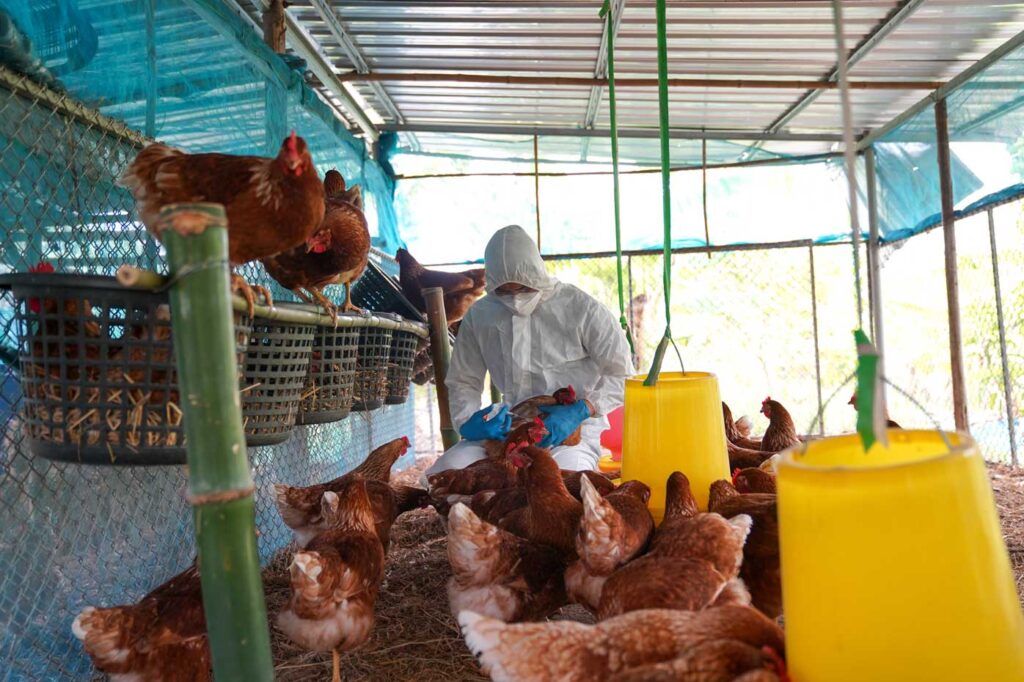Combating Bird Flu: India’s Multi-Layered Approach
India has implemented a multifaceted strategy to control Avian Influenza (AI), a contagious disease affecting birds and posing a potential threat to human health. The country’s approach emphasizes surveillance, culling, biosecurity measures, and vaccine development, guided by the “One Health” framework that recognizes the interconnectedness of human, animal, and environmental health.

Surveillance:
- India’s AI surveillance plan involves continuous monitoring of poultry populations, including commercial farms, backyard birds, and live bird markets, particularly in border areas and regions frequented by migratory birds.
- Surveillance methods include:
- Passive surveillance: Relies on stakeholders, including poultry producers, veterinarians, and wildlife officials, to report unusual sickness or mortality in birds.
- Active surveillance: Entails targeted investigations by veterinary authorities, involving clinical examinations and sample collection from at-risk bird populations.
- Sample collection targets various types of birds and environmental materials, such as swabs from sick birds, carcasses, droppings, and water sources.
Culling:
- Culling, or depopulation, of all poultry within a defined “Infected Zone” (1 km radius from the confirmed case) is a cornerstone of India’s AI control strategy.
- The “Surveillance Zone” (1-10 km radius) acts as a buffer, with restrictions on bird movement and enhanced monitoring.
- Culling is carried out humanely using methods like cervical dislocation, with anesthesia for larger birds.
- Compensation is provided to farmers for culled birds.
Biosecurity Measures:
- Strict biosecurity measures are advocated to prevent AI spread, encompassing:
- Restricting access to poultry farms: Limiting visitors and preventing contact between poultry and wild birds.
- Maintaining cleanliness: Regularly cleaning bird cages and changing food and water.
- Quarantining new birds: Separating newly introduced birds from the existing flock for a minimum of 30 days.
Vaccination:
- While India’s current strategy prioritizes surveillance and culling over vaccination for Highly Pathogenic Avian Influenza (HPAI), the development of indigenous vaccines is actively pursued.
- Challenges with HPAI vaccines include:
- Partial immunity, reducing disease severity but not completely preventing infection or viral shedding.
- Potential emergence of vaccine-resistant strains.
- Difficulties in ensuring strict biosecurity, particularly in backyard poultry settings.
- ICAR-NIHSAD, Bhopal, has achieved a breakthrough by commercializing a vaccine against Low Pathogenic Avian Influenza (LPAI-H9N2), a strain causing significant economic losses in Indian poultry.
- Research on cell-culture-based HPAI vaccines for both poultry and human use is underway at institutions like ICAR-NIHSAD and ICMR.
One Health Approach:
- The “One Health” approach underpins India’s AI control strategy, promoting collaboration among various stakeholders, including animal health, human health, and wildlife sectors.
- This collaborative approach aims to strengthen surveillance, particularly at human-animal-wildlife interfaces, and deploy Joint Response Teams for effective outbreak management.
Key Points:
- India’s AI control strategy emphasizes proactive measures to prevent and contain outbreaks, employing a combination of surveillance, culling, biosecurity, and vaccine development.
- The country’s first indigenously developed LPAI-H9N2 vaccine marks a significant step towards protecting the poultry industry.
- Research on HPAI vaccines for poultry and humans signifies a commitment to addressing the evolving challenges of AI.
- The “One Health” framework fosters intersectoral collaboration to enhance preparedness and response to zoonotic diseases like AI.







